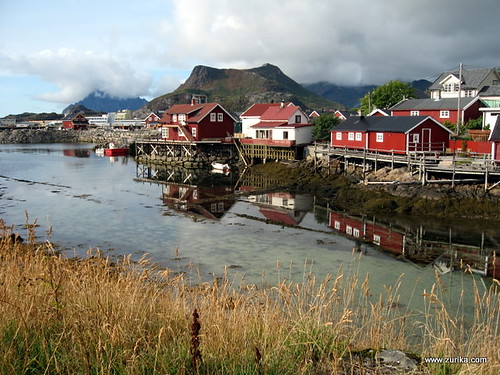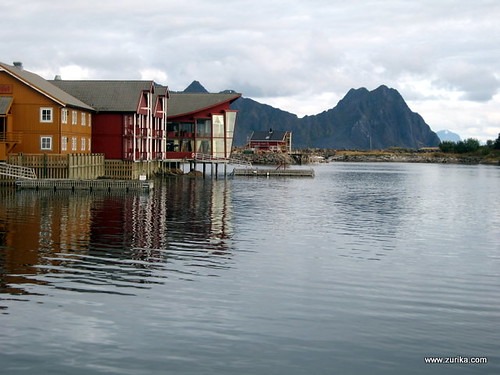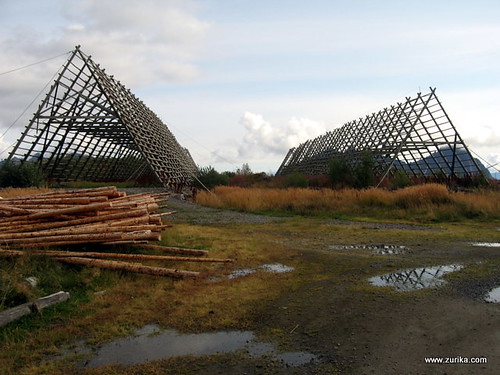The part of our trip I was looking forward to the most was the part north of the Arctic Circle, four days in the Lofoten Islands. The Lofotens form a big, mountainous wall in the middle of the ocean, and are speckled with lakes and fishing villages. These islands receive six weeks of constant sun in the summer and a month of absolute darkness (“Arctic winter”) in the winter. Around this time of year, though, the days were a pleasantly normal length, and although the temperatures were lower than in Oslo, the Gulf Stream keeps it from getting unmanageably cold.
We split our sleeping between Svolvær and Å, and traveled back and forth by bus. The bus ride was sweepingly scenic, but the cost and infrequency of the buses makes me think we’d have been better off renting a car (even though that was also not a cheap option). Our ride back involved a 3-hour layover in Leknes, perhaps the only village on the island that was not at all scenic or interesting. We decided their tourism slogan should be “Leknes: for when you’re tired of the view.” At least they had a liquor store (“vinmonopolet”).
Svolvær (Å will get a post of its own) is known as the capital of the Lofoten Islands, and contains such big-city features as a grocery store and more than one restaurant. It is easy to get to and from since it has an airport and also the Hurtigruten comes daily. There are also many accommodation options here. Although not quite as beautiful as the the smaller villages on the islands, Svolvær was plenty picturesque. Our favorite restaurant in town was Bacalao, a relatively affordable cafe with a variety of food on offer, plus a variety of cocktails, and coffee with free refills (this was something I started to love about Norwegian restaurants, along with the free tap water with lime).
The Lofoten Islands are known for their dried fish production, still done the old-fashioned way: fish are caught and then hung out on these large wooden structures to dry. The fish-drying racks are all over the place. While I’m sure it is quite a site to see, I think I’m happy our trip didn’t coincide with fish season – I don’t know that my sensitive nose could have handled that.
We arrived in the Lofoten Islands via Hurtigruten, and departed via prop plane. Both of these transportation choices offered some fabulous scenery, so I’m glad we did it this way.





Those are some awesomely gorgeous photos, Jul. 🙂
Thanks! It was an awesomely gorgeous place. 🙂
Expensive or not, Norway looks like a beautiful place to visit. I think you should take the EU5,800 cat along with you next time!
The shot of the town at dusk – or is it morning? hard to tell in the arctic – is simply stunning. Will have to travel there when I can afjord it.
Lulu – good idea! Or maybe even just the money. That should buy us a beer or two. 🙂
Molly – Thanks! Yep, I’m pretty sure it’s dusk (although we took so many pictures all day long, it could be either). Hope you can afjord it soon. 🙂
The Lofoten islands are such a beautiful part of Norway and your pictures are superb. The Hurtigruten voyages are also a great way of seeing them.
looks absolutely breathtaking
Hi,
Just came upon your blog from a link from Blogher on Oktoberfest. We love Munich and are tossing around the idea of a trip to Norway next year. Perfect timing to start reading your posts. Your pictures are beautiful!
Lori – welcome! A good friend of mine is moving to Brazil in a month, so I hope to make it there to visit someday soon.
Svolvær and Å are absolutely gorgeous. But my favorite village in the Lofoten Islands is hands down… Reine. Hamnøy is good too, its remoteness and lack of light pollution makes it a wonderful place to spot aurora.